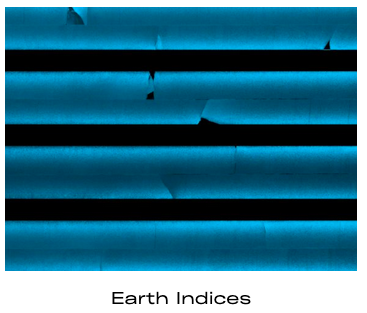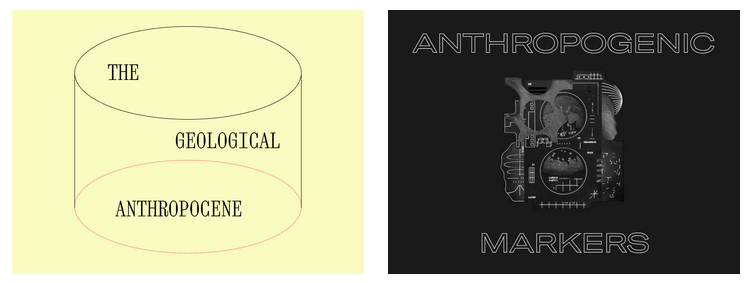The Examination of Geological Evidence
The task of the AWG was to evaluate the actual reality of the Anthropocene as a distinctive geological time unit. The group was formed in 2009 by the Subcommission on Quaternary Stratigraphy (SQS) of the International Commission on Stratigraphy (ICS), a committee that oversees the standards and requirements of the ongoing review and completion of the geologic time scale. In order to place a new, human-made epoch at the current end of that timescale—encompassing 4.5 billion years of geological evolution—the working group had to consider the Anthropocene according to the formal criteria of chronostratigraphy and the stringent and rigorous benchmarks laid out by the ICS. This meant, foremost, to carefully document, analyze, and date a variety of geological sections to identify the potential reference point for the lower stratigraphic boundary of the Anthropocene epoch, the so-called Global boundary Stratotype Section and Point (GSSP, colloquially called the “Golden Spike”). The establishment of a GSSP is the formal requirement for official recognition of a new geological time unit: an unambiguous record of a permanent physical, chemical, or biological change in the geological archive that occurred worldwide and simultaneously.
The question the AWG had to deal with was therefore not only to assess whether we have indeed already entered a new geological epoch. It also had to examine when exactly it began and what kind of material signature would mark such a distinct boundary separating the old and the new Earth. After intensive deliberations within the AWG, it became apparent that it would be most promising to focus investigations on the mid-twentieth century, a period when human industrial activity became so pronounced and global that it is now commonly referred to as the “Great Acceleration.” After the HKW organized funds for the necessary stratigraphic research (with the MPG providing some of the lab facilities), the project became concrete around 2018, when the AWG assembled several research teams from around the world to search for the definitive anthropogenic signal. For this purpose, samples from a range of environmental archives—polar ice, tropical corals, mountainous peat bogs, lacustrine sediments, and so on—were analyzed for specific human-made markers such as artificial radionuclides, combustion particles, neobiota, and organic pollutants. These measurements were then weighed to establish the extent to which they might meet the criteria for a GSSP. The results were published in a Special Issue of The Anthropocene Review, including an epilogue co-authored with the HKW and MPIWG project partners on the role of their collaboration in the research process.
There exists hardly any example in the history of geology where empirical research of this kind has been conducted under such immense professional and public scrutiny. Chronostratigraphy, by its own definition, is about the (more or less) deep past. It had therefore always excluded human activities. Yet what the AWG conducted was a geological analysis of the human fingerprint in the Earth’s archive, barely 70 years old: an unheard-of “geology of the present.”
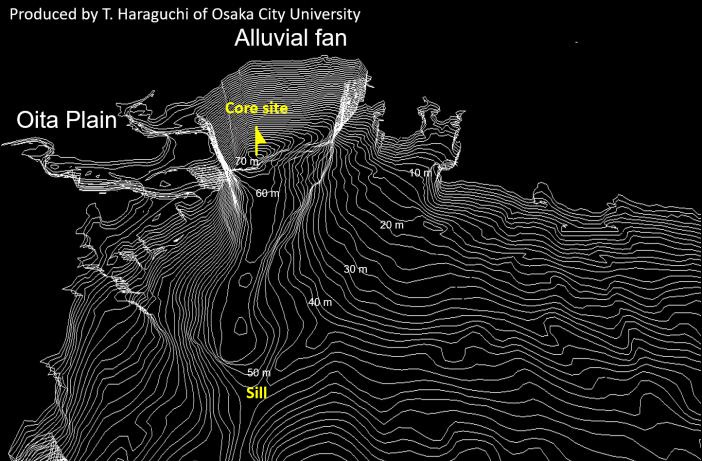
Topographic map of the Beppu Bay basin in Southern Japan with the location of one of the GSSP-candidate cores marked. Photo: Tsuyoshi Haraguchi © All Rights Reserved.
Beyond Stratigraphy: Scientists, Activists, and Artists
Moreover, the “geologists of the present” also faced further pressures from outside their own professional circle. As a conceptual intervention and chosen keyword of the present moment in Earth and human history, the Anthropocene already encompasses much more than the confirmation of an epoch by means of the traditional standards of chronostratigraphy. With its widespread popularization in academic, artistic, and media circles, the Anthropocene has long become a metacategory bracketing the multiple crises that humans and non-humans are now facing, including the historical origins of these crises and the unjust distribution of its effects. In short: the Anthropocene has become a point of attraction for far-ranging intellectual and political debates. At the bottom of this, however, lies a fundamental change of perception of human agency, demanding new ways to cross-connect and integrate different forms of knowledge.
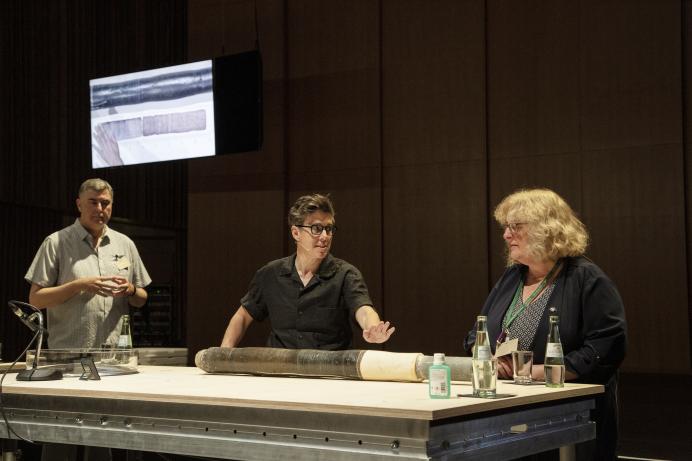
AWG members Francine McCarthy and Mark Williams discuss a GSSP-candidate core from Crawford Lake with historian of science Michelle Murphy at HKW in May 2022. Photo: Katy Otto/HKW.
Since 2012, the MPIWG and HKW have been teaming up with members of the AWG and hundreds of other researchers, artists, and activists from around the world to explore the origins, implications, and cross-connections of Anthropocene knowledge in exploratory ways. The legacy of that unusual collaboration is represented by the multitude of projects, voices, and results gathered on the joint platform anthropocene-curriculum.org, a co-learning space where the pairing of geological evidence with cultural experimentation has resulted in multiple forms and formats. The website is now maintained by the MPIWG as a public repository, while the widespread international network continues its activities via a decentralized, self-organized approach as the Anthropocene Commons.
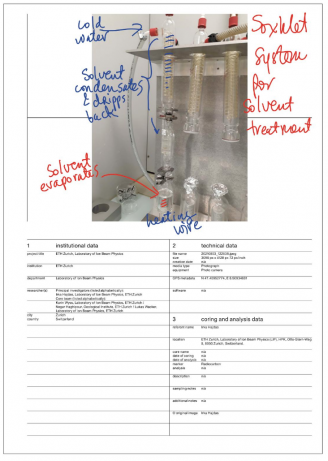
The work of the 12 research teams has been accompanied by the artists Giulia Bruno and Armin Linke. Their exhibition Earth Indices, consisting of more than 600 annotated metadata sheets like the above, facilitated the creation of a multilayered archive of the Anthropocene GSSP investigation. Photo: © Giulia Bruno and Armin Linke with HKW and scientists of the AWG.
Click here for full-size image.
Historical Legacies and Future Responsibilities
Now that the collaboration draws to a close, the crucial project question is being revisited in a new light: What can the Earth's recent archives teach us about the latent legacies of industrialized humanity and its temporal agency for a future that has already begun? Since the start of the cooperation in 2012, the world has become quite a different place. The contours of the dawning Anthropocene are emerging ever more clearly from the background noise of Earth's natural variability, upheavals that already contribute towards societal conflicts and continuous efforts of crisis management. We can see a serious discrepancy between the highly dynamic changes of the Earth system and the inert responses of traditional institutions, knowledge systems, and legal and political structures and tools. Time corridors for avoiding irreversible damage to the wellbeing of the planetary whole rapidly narrow. Delays in responding to the imminent danger of planetary change—if not deliberate prevention of ambitious action—become questions of historical responsibility between generations born before and after the realization and geological recognition of the new epoch. Adding such “temporal” justice to efforts around social and ecological justice is one of the fundamental reconfigurations that the Anthropocene demands.

“What damage can be repaired?” Questions like these were discussed in experimental settings during the event "Where is the Planetary?" at HKW in October 2022. Photo: Katy Otto/HKW.
Consequently, attention must now be focused on the societal necessities and possible actions appropriate to the dynamic nature of the Anthropocene’s signals. Are we, as human communities, structurally capable of weaving exactly the network that will lead us from the evidence to not only the technological but also the social innovations that will help to at least decelerate the planetary crisis? Do we comprehend the legacy of the twentieth century and the Great Acceleration so meticulously studied by the AWG, to halt this ominous development and keep crisis dynamics at bay in the twenty-first century? As the transdisciplinary cooperation between the AWG, HKW, and MPIWG has shown, research engagements that cross formerly separate domains of knowledge and daily routines might be well suited to actively respond to these challenges ahead.
Researchers from the AWG, the MPIWG, and the new MPIGEA, as well as the global Anthropocene Commons network, which includes former team members from the HKW, will continue to engage in Anthropocene-apt transdisciplinary research.
